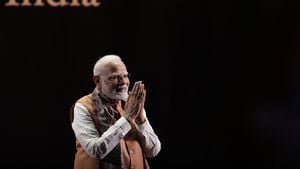Delhi, renowned for its rich history and vibrant culture, is currently grappling with one of the worst air pollution crises it has ever faced. The city’s air quality has plunged to 'severe' levels, causing widespread concern and prompting immediate action from the government and local authorities. Recent data shows the Air Quality Index (AQI) has soared over 400, with specific areas like Anand Vihar and Mundka recording alarming levels above 488. This unsettling scenario has created not only environmental challenges but also health crises, as residents filter their daily routines through the haze of pollution.
With the air quality reaching dangerous thresholds, many residents are feeling more compelled than ever to leave the capital. Reports indicate significant demographic shifts as families temporarily relocate to their hometowns, seeking refuge from the toxic air. Rahul Gandhi, the Leader of the Opposition, labeled the crisis as a 'national emergency' on social media, urging immediate government intervention to safeguard public health, particularly for children and the elderly, who are most vulnerable to the negative impacts of air pollution.
To address the plummeting air quality, the Railway Board has taken significant steps to adapt its operations. Following the Central Government’s directives due to the hazardous conditions, the board has introduced staggered work hours for its employees. This innovative approach allows for reduced travel during peak pollution periods, encouraging efficient commuting practices like carpooling. Employees are now slated to work from 9 AM to 5:30 PM or 10 AM to 6:30 PM, depending on their operational requirements. These changes aim to mitigate exposure to polluted air without compromising work productivity.
Despite these efforts, daily life continues to be heavily impacted. Schools have switched to online classes to protect students, and many residents are reducing outdoor activities significantly. Morning walks, once commonplace, have become rare as the fear of health complications looms large. Indeed, the air quality crisis has not only disrupted routines but also led to health professionals reporting increases in respiratory conditions, including 'walking pneumonia' cases linked directly to the rising pollution levels.
Interestingly, the Indian government is holding steadfast on certain preventative measures, such as opposing the establishment of judge panels to monitor stubble burning, which is often cited as one of the pollution's contributing factors. Critics argue this could undermine the efficiency of environmental management strategies. Meanwhile, even calls for innovative solutions, such as cloud seeding to counteract pollution, have been deemed unfeasible by environmental agencies, adding to frustration among residents who feel the existential threat of polluted air.
Several embassies within Delhi have also begun to act, with expatriates and diplomats expressing growing concern for their health and safety. Various diplomatic missions are coordinating measures to accommodate their personnel until the air quality improves. Work-from-home options are being extended to facilitate mobility without health risks.
At the heart of the issue is India's commitment to combating air pollution systemically. For this purpose, different governmental strategies are being evaluated, highlighting the need for long-term, sustainable solutions rather than temporary band-aid fixes. The focus is on coordinating across states to implement policies on stricter emissions, vehicle standards, and the promotion of cleaner energy sources.
For now, the people of Delhi are caught between staying put to deal with daily life amid worsening pollution or fleeing to safer zones impacts of environmental non-compliance and slow governmental responses. Each day brings new reports and challenges as families negotiate living with dangerously polluted air, adjusting their lives with hope for effective future interventions.
Although leaders and citizens alike are calling for immediate action, implementing sustainable changes will require persistent efforts, collaboration, and substantial policy reforms. Until the crisis is deliberately and urgently remedied, Delhi will remain under the omnipresent cloud of smog, leaving its residents to wonder about the price they are paying for urban living.
The urgency for cleaner air, combined with the political will to stabilize the situation, sets the stage for necessary reforms, which many hope will turn the tide against this grave public health crisis.



